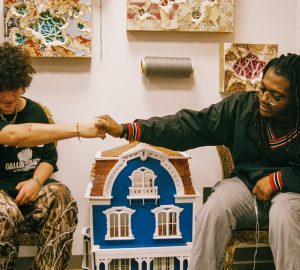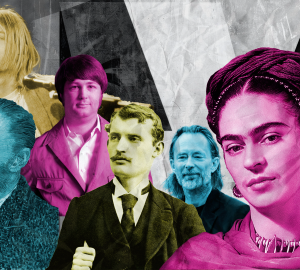The Writer’s Corner features poetry, essays, short stories, satire and various fiction and non-fiction from SCAD Atlanta students. To submit your own work for the Writer’s Corner, email features@scadconnector.com.

‘Art for Autism’ by Amanda Glover.
I was five or six, giving my stuffed animals names, creating backstories for my dolls and living in princess dresses; I can barely remember what I was like back then. What I remember most is being the sensitive girl who cried over songs about bullying and when her ride didn’t pick her up from school exactly when they usually did, and I do remember what it was like growing up with a younger brother. I believe I better understood how my brother was different once our mother started taking him to speech therapy and feeding clinics. Every year at summer camp, I was embarrassed by his behavior. My mother told me when my brother was two or three — the ages when the signs usually begin to appear — my dad told her he could barely understand my brother when they spoke on the phone.
Autism is a span of conditions identified by repetitive behaviors and difficulty with social skills, including communication. It affects one in 59 children with boys being four times more likely to be affected than girls. “Women on the spectrum tend to favor artistic endeavors while men are more often drawn to science or mathematics. That’s why a lot of women aren’t diagnosed until later in life, because their talents don’t follow the traditional model of “this is what autism looks like”,” quotes part-time professor and published author, Carlie Sorosiak.
My brother recently turned 19, though his maturity level is that of a 13-year-old. Academically, he does very well; A’s in all his classes and even helps some of his classmates with their assignments. Our parents made the decision to hold him back in the eighth grade, because they didn’t believe he was ready to start high school and so he could get into Tapestry, a school for special needs students. Since that school didn’t provide the proper resources for him, our parents enrolled him at our home school. Though he prevails academically, he needs improvement socially and behavior-wise. People admire him at school, but he doesn’t know how to keep the conversation going. His go-to answer, when asked about his day, is, “good.” We have to dig deeper to find out more, such as ask what he did and what he learned. Not everyone makes the effort to get real answers out of him. We try not to settle for one-word responses. Sometimes when he doesn’t feel like talking or answering questions, he’ll mumble and stutter, or say “I don’t know.”
The past year, my brother has expressed interest in getting to know kids his age. Our parents have gotten him involved in music groups and sports, and though his interest in sports was short-lived, his admiration for music continues. In the first grade, our mother arranged for one of the music teachers to teach him to play the piano, and sometimes I would sit and listen. In the past, he would listen to jazz and the blues but these days he’s gotten more into pop music. At one period, he was fascinated by the drums. These days, he plays his keyboard and records specific notes on his cellphone. One day, I realized the song he’d been playing on the keyboard was “Something Just Like This” by The Chainsmokers. I’ve noticed he’s had a greater fascination with the beats and background music in songs than the lyrics. He’s been able to mimic and record beats I never realized were there.
Those with autism pay much attention to detail. For instance, my brother has always been impressed with cars. He’s taken many photos of different cars and researches how certain parts work; when we go over relatives homes, it’s not uncommon that he asks to look inside their cars.
He also has a very good memory. Sometimes when we go out with the family, our mom asks him which way we go to get to our destination just to be in awe of the precision of his memory. When plans are made to do something he’s looking forward to, he doesn’t let anyone forget; even if he has to remind everyone in the house several times a day. This can involve baking, going to see a movie, going to a thrift store, amusement park, grocery store or bike riding.
As I stated, those on the spectrum engage in repetitive behaviors. My brother has a habit of asking the same questions, watching the same movie several times a day, or listening to the same song on repeat. When certain phrases are spoken, he’ll repeat them to himself or to others.
My brother is a picky eater. He doesn’t like trying new foods. His favorites are pizza, macaroni and cheese, meat, broccoli, lasagna, Halo oranges, chicken pot pie, noodles and chocolate desserts. He doesn’t drink anything but water and orange juice. When he does eat, they’re in small portions. Because of this, he is underweight and is the reason my mother used to take him to feeding clinics, so he would get the proper nutrients.
Those with autism have trouble communicating or would rather keep to themselves. My brother has no problem asking questions, but doesn’t always want to answer them. When the family goes out to dinner, to a relative’s house, or a department store, he’ll watch videos on his phone with earplugs in. They can also have trouble expressing their emotions. When my brother is frustrated or unhappy, he’ll knock things over, or throw things on the ground. Those on the spectrum are also sensitive to physical touch. My brother has never been one to give hugs — he’s more of a slight pat on the back kind of guy.
He’s grown out of many of his habits. When we were in elementary school, he would burst into tears at the sight of me with my class. He used to have a fascination with the painted arrows on the roads. He would close his eyes and turn his head whenever we drove under bridges. I recently asked him why he used to do that and he said: “I don’t know.” Even our mom said she could never figure out why. He also had an obsession with digital clocks. My brother would get upset if he missed seeing two zeros on the clock on the microwave. I remember when we all came home one night a few minutes past ten-o’clock, and my brother cried like he’d just been given the worst news possible. Our dad had turned back the time to please him.
In the past, and at times now, my brother mimics the sound someone makes when they cry; specifically me. He also mimics tones he hears on TV or the radio if they humor him.
Some of his other habits have stayed with him to this day. We have to keep an eye on him when we go out to make sure he doesn’t get distracted and wander off. At times, he must be reminded to do daily tasks such as brushing his hair, washing his face, or dressing appropriately for outside. He turns his head or closes his eyes whenever we drive by a long row of bushes because he doesn’t like the way they’ve grown. Not too long ago, he wanted us to have a pet cat. But for a while after our mom said no, the sight or mention of a cat would upset him. He is also an intense cleaner. When we wash dishes together, I wash then he rinses. He always hands them back to me if they aren’t cleaned to perfection. When our Chihuahua uses the bathroom on the floor instead of the pad, my brother makes sure the floor is sprayed and scrubbed clean.
Though my brother has his limits, he has his strengths. He’s spent most of his childhood drawing. He never went anywhere without a bag or paper, crayons, and pencils. He is able to notice the beats and sounds in music others wouldn’t have thought about. He can copy the music he hears in songs on his keyboard.
There are many others on the spectrum with artistic talents. Dami Idowu, a 20-year-old British illustrator worked on drawings for a children’s book. He has autism as well as a learning disability. Dami uses his artistic skills for communication, relaxation, as well as focusing.
Megan Rhiannon, a 21-year old illustration student at Cambridge University got her inspiration from daily tasks and experiences. In the notebooks she collects, she documents details she notices in other people, as well as conversations she hears on buses. She states documenting these details makes her feel calm.
Stephen Wiltshire is a British architectural artist, as well as an autistic savant; which is a condition where a person exhibits extraordinary skills that rise from a developmental disability, or a central nervous system disorder. Stephen is known, and has a talent, for drawing lifelike representations of cities; sometimes after only seeing them for a short period of time.
During my fall quarter last year at SCAD, I was lucky enough to have Carlie Sorosiak as a professor. I remembered her mentioning her mother being on the spectrum. I reached out to her via email and she informed me that her mother is a brilliant writer and can easily figure out complex ideas when it comes to literature.
We all have things we do to make ourselves feel calm. For my brother and me, it’s art and music. I see his future possibly involving car designs, or music composing. In the past when asked about possible careers, he’s given many answers.
In conclusion, individuals with autism might share differences, but they also share similarities to those not on the spectrum. Creativity comes in many forms. My mother calls autism: “The New Normal.”


























